As mentioned in my previous post on Sutton Common, October 25th was set to be a planting day – and plant we did!

With a great group of volunteers we sunk over 100 new plants into the thick, sticky clay substrate at Sutton Common scrape. We even did some seeding and thistle pulling to round out the day – well done everyone!
All the plants selected for planting at Sutton Common scrape had been chosen for their ability to tolerate dampness, wetness and even periods of drought. As the seasonal pond is filled entirely by rainwater and dries out naturally in the summer, using hardy wetland and pond margin plants is important to ensure they survive year on year.
These plants will provide not only nectar and pollen sources for invertebrates but shelter and food for animals throughout the year. The plants chosen will send up flowers at different times, growing at different heights and densities to help diversify the habitat of the pond, allowing it to be useful to wildlife in as many ways as possible each year.
Here are the species we planted, so you can keep an eye out for them in the future! It’s worth noting though, it may take some time for them to become properly established.
Common Fleabane (Pulicaria dysenterica) Pic ©

This native member of the daisy family is a pretty feature of damp settings throughout England, supplying Bees, Hoverflies and Butterflies an important source of pollen and nectar in the late summer. This densely hairy plant can grow up to a metre tall in good conditions and the 15-30mm flowers grow in clusters from July to September.
Creeping Jenny (Lysimachia nummularia) Pic ©
 Creeping Jenny is an attractive plant of pond margins, wet grassland and river banks, common particularly in the South of England. As the name suggests it creeps, low to the ground through other vegetation, preferring the shade to full sunlight. It has heart shaped or rounded green leaves and sends up cup shaped yellow flowers in the summer from May to August.
Creeping Jenny is an attractive plant of pond margins, wet grassland and river banks, common particularly in the South of England. As the name suggests it creeps, low to the ground through other vegetation, preferring the shade to full sunlight. It has heart shaped or rounded green leaves and sends up cup shaped yellow flowers in the summer from May to August.
Cuckoo Flower/ Lady’s Smock (Cardamine pratensis) Pic©
 Cuckoo Flower, also known as Lady’s Smock is a beautiful, delicate flower of damp grassy areas – it has my vote (possibly tied with Flowering Rush – see below) for the prettiest plant in the list. Its pale pink to mauve flowers are a herald of springtime, said to coincide with the arrival of the first Cuckoo (although I think you’d be incredibly lucky to see a cuckoo on Sutton Common!)
Cuckoo Flower, also known as Lady’s Smock is a beautiful, delicate flower of damp grassy areas – it has my vote (possibly tied with Flowering Rush – see below) for the prettiest plant in the list. Its pale pink to mauve flowers are a herald of springtime, said to coincide with the arrival of the first Cuckoo (although I think you’d be incredibly lucky to see a cuckoo on Sutton Common!)
Cuckoo flower is a main larval food plant of the Orange Tip and Green Veined White butterflies – so with any luck we’ll see an increase in these related species too!
Flowering Rush (Butomus umbellatus) Pic©
 Despite the name, flowering rush is not a ‘true’ rush in the Juncus genus, but one of the two known members of the Butomaceae family. It is a tall and highly attractive plant with umbels of pinky purple flowers on show in June and July. We planted these in the middle of the seasonal pond as they tend to prefer wetter conditions, often growing in shallow water and the margins of ponds, rivers and canals.
Despite the name, flowering rush is not a ‘true’ rush in the Juncus genus, but one of the two known members of the Butomaceae family. It is a tall and highly attractive plant with umbels of pinky purple flowers on show in June and July. We planted these in the middle of the seasonal pond as they tend to prefer wetter conditions, often growing in shallow water and the margins of ponds, rivers and canals.
Glaucous Sedge (Carex flacca) Pic©

Sedges are grass-like plants with angled stems (most are somewhat triangular).
Glaucous Sedge is so called because it’s leaves are glaucous – a very specific term meaning a greyish blue-green.
Sedges are very hardy and can be found in both dry and wet conditions, growing in low clusters on grassland and moorland throughout the UK.
The inconspicuous browny-red flowers tend to grow in groups of 3 female flowers, near the top of the stem, and 2 male ones further down.
Great Burnet (Sanguisorba officinalis) Pic©

At up to a metre in height, Great Burnet has serrated green leaves and egg or lollipop shaped red flowers which attract pollinators in the wet meadows and grasslands where it grows.
It flowers from July to September but the dead flowers can persist long into the winter.
Greater Birdsfoot Trefoil (Lotus pedunculatus) Pic©

Greater Birdsfoot Trefoil looks a lot like it’s little brother, Lotus corniculatus , only larger with a stout, hollow stem and tiny hairs on the leaves. It also enjoys damper habitats.
Greater Birdsfoot Trefoil has dark green foliage and bright yellow flowers from June to August before developing into the ‘birds foot’ shaped seed pods which give the plant it’s name.
A member of the pea family, Greater Birdsfoot trefoil is the only British legume to grow in wetlands!
Gypsywort (Lycopus europaeus)

We already had Gypsywort growing at Sutton Common so we hope all that we planted will thrive there.
With its serrated green leaves and small white flowers, Gypsywort can be easily mistaken for a nettle or a mint – to which it is quite closely related.
Its small flowers are commonly visited by flying insects like hoverflies, who feed on them in the summer to early autumn.
Rushes – Hard, Soft and Jointed (Juncus sp. – inflexus, effusus, articulatus) Pic©

I’ve placed the Juncus species in one section here as they are superficially quite similar.
In general, hard rush is harder and darker than soft rush – both of which have single inflorescences, and jointed rush has more flowering heads than both.
Rushes grow in dense grassy stands and offer good shelter for birds and small mammals.
They are also eaten by many species of invertebrate including a number of moths which use them as larval host plants.
Hemp Agrimony (Eupatorium cannabinum) Pic©

Hemp agrimony gets the ‘hemp’ part of it’s common name and the ‘cannabinum’ in the Latin from a passing resemblance to the well known ‘weed’ Cannabis sativa.
The deeply three-lobed, toothed leaves do look somewhat reminiscent of the narcotic plant, but the clusters of pretty pink flowers make Hemp Agrimony an attractive plant in and of itself, offering a food source for butterflies such as Red Admiral and Small Tortoiseshell from July to September.
Purple Loosestrife (Lythrum salicaria)

Purple Loosestrife is a large flowering plant with striking pink to magenta blooms of flowers, which are visited by many types of invertebrates.
In the height of summer (June to August), long tongued species such as the Elephant hawk moth and the Brimstone butterfly can access it’s sweet nectar.
The long green stems are flanked by pointed leaves growing opposite each other, and the flowers grow in large conical arrangements.
Ragged Robin (Lychnis flos-cuculi) Pic©
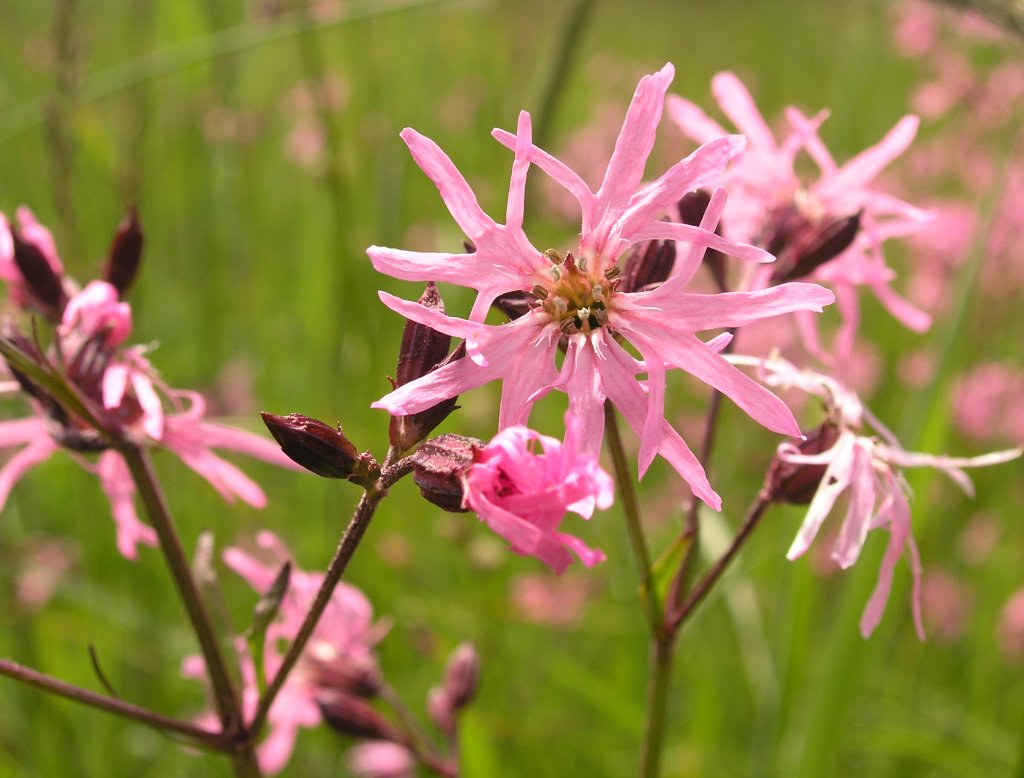 Ragged Robin is a beautiful plant. Its bubblegum pink flowers remind me of me somewhat, not because they’re pink but because they’re raggedy and scruffy, hence the name.
Ragged Robin is a beautiful plant. Its bubblegum pink flowers remind me of me somewhat, not because they’re pink but because they’re raggedy and scruffy, hence the name.
Interestingly the specific epithet flos-cuculi means ‘flower of the cuckoo’, for the same reason as the Cuckoo Flower mentioned earlier!
The flowers are used as nectar sources by namy butterflies including Small and Large Whites, Brimstones and Orange-Tips.
Sneezewort (Achillea ptarmica) Pic©
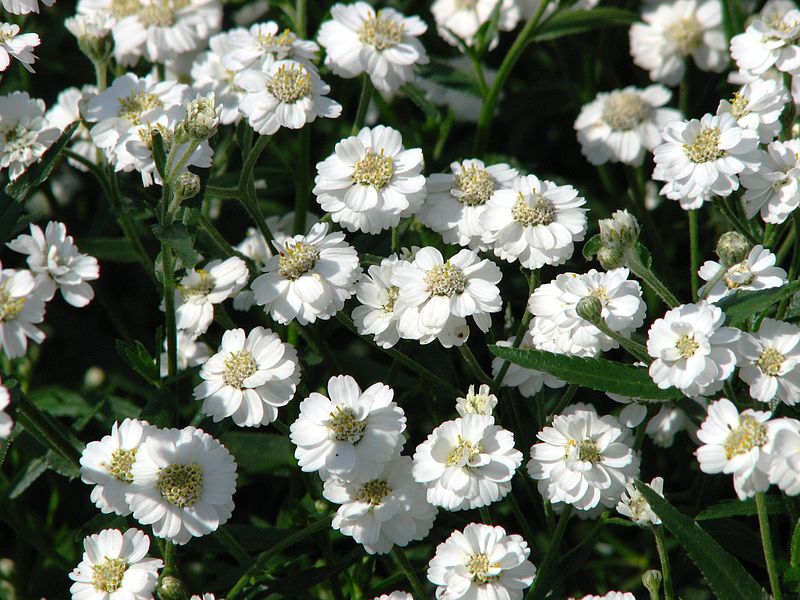 Sneezewort is related to the rather more common Yarrow (Achillea millefolium), which I can tell you makes a rather lovely tea. Sneezewort however, was apparently used as a sneezing powder in the past – why one would want to induce sneezing is anyone’s guess!
Sneezewort is related to the rather more common Yarrow (Achillea millefolium), which I can tell you makes a rather lovely tea. Sneezewort however, was apparently used as a sneezing powder in the past – why one would want to induce sneezing is anyone’s guess!
Sneezewort has feathery leaves and pretty white and off-white flowers which are particularly good for hoverflies, who apparently don’t sneeze.
Water Figwort (Scrophularia auriculata) Pic©
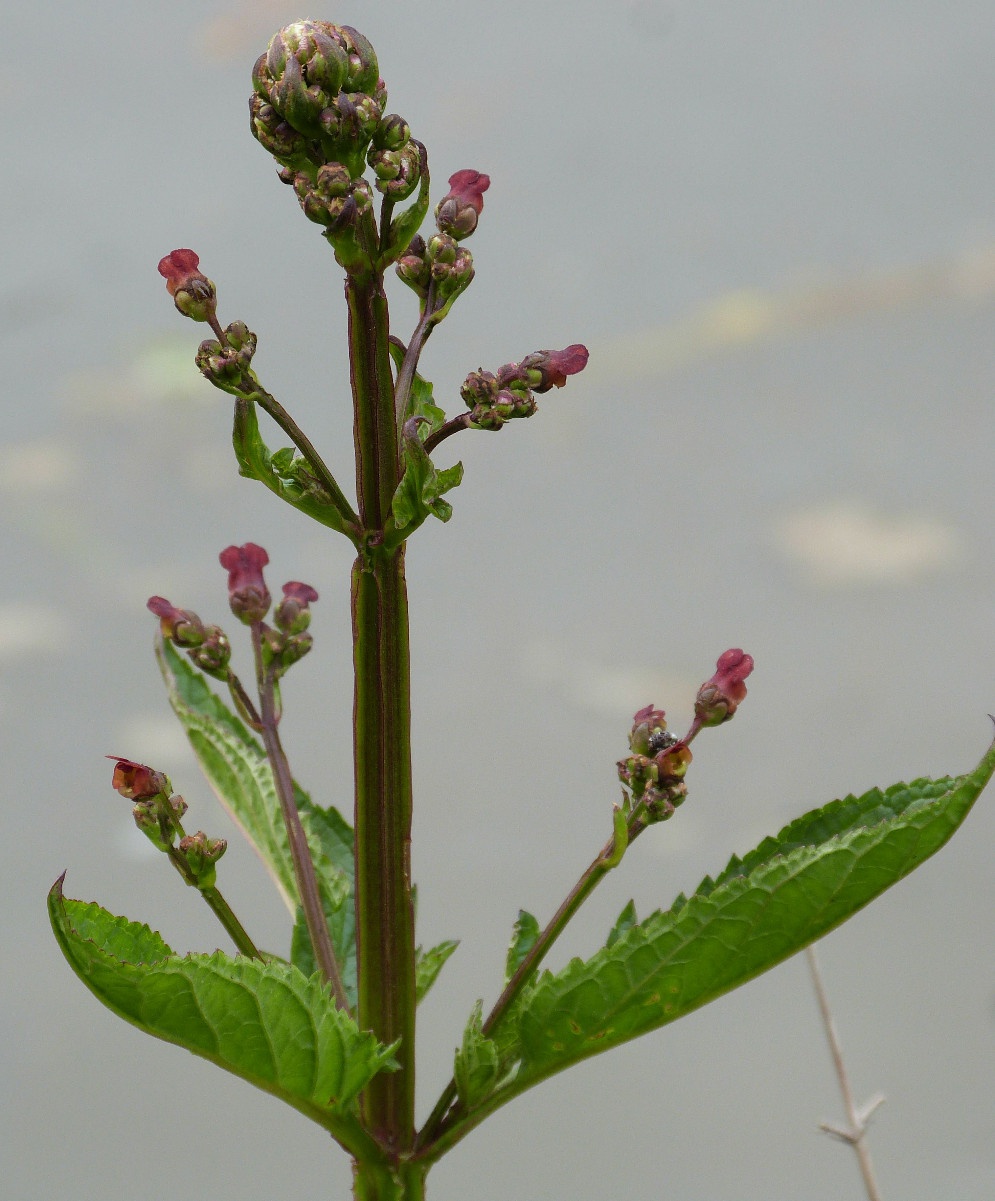 Water figwort is a long-flowering plant (June to September) with deep crimson flowers which are pollinated by various bees and the common wasp.
Water figwort is a long-flowering plant (June to September) with deep crimson flowers which are pollinated by various bees and the common wasp.
The red stems are noticeably 4-ridged and flanged, and the leaves are toothed. The specific epithet auricularia refers to the ‘ears’ or lobes at the base of most leaves (this may not be observable when the plant is immature) – this is visible on the bottom right leaf in the picture.
Meadowsweet (Filipendula ulmaria) Pic©
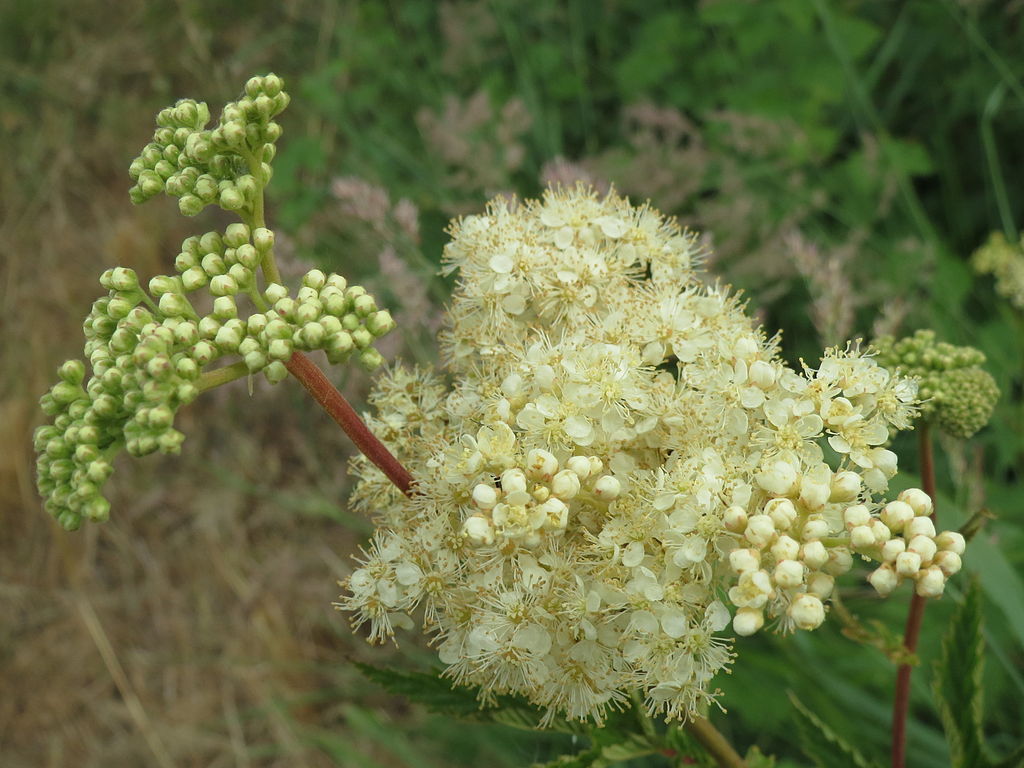 Meadowsweet is a sweet smelling plant of wet meadows, once used to flavour meads with its fragrance.
Meadowsweet is a sweet smelling plant of wet meadows, once used to flavour meads with its fragrance.
While in flower, you might notice Meadowsweet by it’s smell before seeing the actual flowering heads. They are just as pleasant as the aroma, with sprays of tiny, creamy white flowers atop long stems – which are very popular with certain fly species.
Devil’s Bit Scabious (Succisa pratensis) Pic©
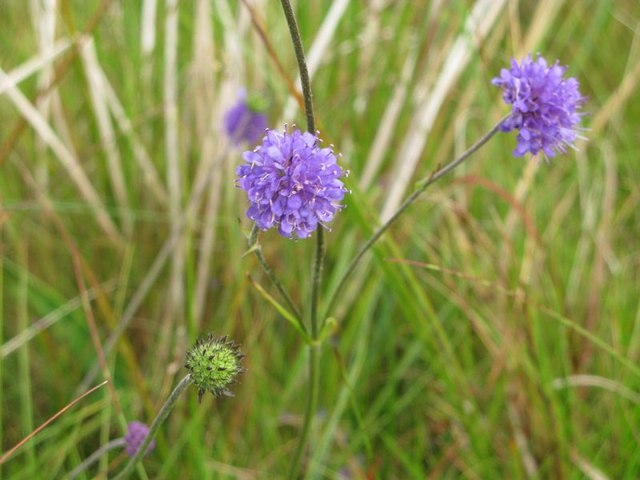 Devil’s bit Scabious flowers long into the Autumn with its rounded, blue, nodding flower heads on show from July to the end of October.
Devil’s bit Scabious flowers long into the Autumn with its rounded, blue, nodding flower heads on show from July to the end of October.
These flower heads attract a great many butterfly species including some Skippers, Hairstreaks, Peacocks, Gatekeepers and Meadow Browns, making it a great plant to have around.
Let’s hope we see more butterflies at Sutton Common as a result!
Autumn Hawkbit (Leontodon autumnalis) Pic©
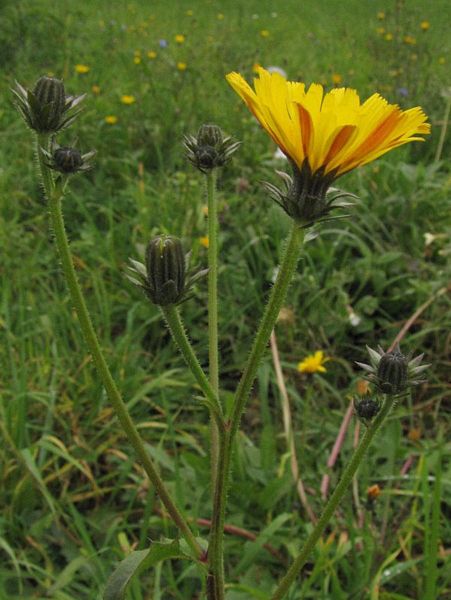 Autumn Hawkbit is a dandelion like ‘yellow composite’ – meaning that it looks a lot like a lot of other little yellow flowers!
Autumn Hawkbit is a dandelion like ‘yellow composite’ – meaning that it looks a lot like a lot of other little yellow flowers!
Autumn Hawkbit has an orange ‘strap’ marking on the underside of the petals, and short hairs on the stems.
Autumn hawkbit is a very hardy plant that will tolerate wetness, making it ideal for our scrape. The flowering season is (as you might have guessed from the name) similar to that of Devil’s Bit Scabious (above) meaning that even into autumn we should have a good supply of nectar for visiting invertebrates.
And there we go!
All in all, 19 species, and over 100 plants! With the flower gods on our side, the work we did on Wednesday will make Sutton Common Scrape a wildflower haven in coming years, providing the basis for a fully fledged wet meadow ecosystem to thrive! Well done team! Thank you all so much!
-Adam






